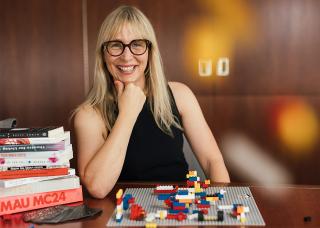Accounting. Marketing. Leadership. Lego?
How UBC Sauder’s Dr. Kari Marken challenges her Creativity students with purposeful play

How UBC Sauder’s Dr. Kari Marken challenges her Creativity students with purposeful play

In spring of 2022, we asked our teaching faculty to tell us who among them were offering innovative learning experiences, environments, and/or introducing new ways of overcoming barriers in their classes. This is part one in a six-part series recognizing teaching faculty at UBC.
Picture a typical MBA course, and you’re likely to envision students engrossed in classes on topics such as Organizational Behaviour, Economics, Management and Business Ethics. Enter Dr. Kari Marken’s Creativity course classroom, however, and you’d be in for a surprise. After all, playing with Lego bricks or drawing on papered walls aren’t exactly the activities taking place in most offices or boardrooms—but speak with Kari long enough and you’ll start to believe they probably should be.
“To create is to bring something into existence,” the lecturer shares, “and if we look at it that way, that's what we're all doing all the time in our work—we’re creating things. If you're leaving a business school with an MBA or a Master's, there's a degree to which you should have some fluency in how to lead others through a creative process to generate better solutions.”
Creativity, which has been a requirement for completion in Masters of Management and Full-Time MBA programs for many years, is one of a number of courses taught by Kari since September 2020, when she joined the UBC Sauder School of Business. Rather than giving lengthy lectures, Kari prefers to catalyze students’ creativity by drawing on her diverse background in teaching and the arts. Her résumé includes, among other things, an early career as a high-school Drama teacher; a Master’s and PhD in Curriculum and Pedagogy; six years as an Educational Designer with the UBC Centre for Student Involvement & Careers; and, finally, her most recent position as a full-time lecturer in the UBC Sauder School of Business.

At every step in her career, Kari says, she brings “the heart and soul of a drama teacher,” and approaches her work with careful attention to a group’s desire to play and build meaning together. Her approach to the required UBC Sauder MBA course is no exception. Early in her career, she shares, she worked at a school that described itself as being “a lighthearted space of serious purpose”—a concept that has stuck and now informs the way she invites students into the Creativity class.
There’s the Lego building, of course, and drawing—alongside exercises drawn from the world of improvisational theatre, design and storytelling to get students into a state of productive “flow.” Once in flow, she explains, “they’re able to work together in ways that, ideally, increase collaboration, team cohesion and focus on working towards bolder and braver outcomes.”
“I'm trying to take this notion of ‘creativity’, which is a concept that we have a lot of preconceived ideas about, and break it down,” she elaborates. “What might creativity actually look like, as a series of verbs or actions, when we're using it in collaborative, co-created professional situations—which is what most of our work experiences are, right? We work alongside people and try to create together.”
“[My students are] able to work together in ways that, ideally, increase collaboration, team cohesion and focus on working towards bolder and braver outcomes.”
Dr. Kari Marken, Lecturer in the UBC Sauder School of Business
Kari acknowledges that, at first, some students require a little more coaxing to embrace the course. After all, these are students who are highly motivated to succeed in the business and managerial worlds, rather than on the stage or in the design studio.
“Many students will walk in and ask me directly, ‘What? Why are we here? What is this?’” she admits. But she notes that those attitudes often come from students’ worries about how to succeed, and their preconceived notions about who is, and is not, creative. It doesn’t take long, however, before their walls come down.
“In the first class, I do a couple of activities that get them looking around the room and realizing that everybody's creative,” Kari explains. “I tell them I have little patience for the idea that some of them are not.” She takes them through some fast exercises to “get them out of their head as quickly as possible in terms of determining who is and is not creative,” before approaching creativity as a learned process, explaining how it comes into play when leading teams. “Then the resistance is mostly gone. And then we have a great time and the students produce phenomenal work together.”

Among the activities she’s had students do is heading out across campus to observe people and report back to the class with a drawing. “I share with them three stories of three creative leaders in three very different fields,” she explains. “One of them embodies the metaphor of a microscope, one embodies the metaphor of a pillar, and one embodies the metaphor of a bartender. Then I'll send them off to campus and have them observe the campus as a microscope, as a bartender or as a pillar, and draw what they see.” When they return, she goes on, “we discuss concepts of metaphor, observation and beauty, and how they might influence our professional mindsets in positive or problematic ways.”
In another activity, Kari will lay large squares representing each one of the United Nation’s 17 Sustainable Development Goals on the floor and on desks, and ask students to stand near the goal that they feel most responsible for contributing to, based on their academic studies and professional experience.
“I'm trying to take this notion of ‘creativity’, which is a concept that we have a lot of preconceived ideas about, and break it down.”
Dr. Kari Marken, Lecturer in the UBC Sauder School of Business

“With their diverse work backgrounds and academic degrees, they’ll start to circle around and create some clusters of people grouped around certain goals,” she shares. “Then, they start working through a design for a social-change process, where we come up with prototype solutions that draw on the different expertise and disciplines they represent. The design process is fast, lively, and loud. And they show their proposed interventions and solutions on large flipchart papers.”
She goes on, “I like to show them that we just had an experience in two hours in the class that was really fun. We were drawing a lot, and there was debate and movement in the room. We were laughing a lot. We were essentially being creative, and we were doing all of those things connected to really critically important goals and a really difficult and sticky problem.”
By encouraging her students to play and explore, she hopes to convey the integral role that creativity plays in all our human endeavours. “When we think about people sitting around trying to solve the toughest problems in the world, we kind of default to sitting around and being very heavy, and it's all about words and talking and debate,” she notes. “I like to show them a different way.”
Written by Jessica Werb, on behalf of UBC Internal Communications
September 2022
Science at the crossroads of creativity and ethics: Dr. Robin Young looks at cell biology through a lens of ethics, diversity and inclusion (Sept. 26)
Necessity is the mother of a delicious invention: Breaking down barriers and redefining how students learn to cook at UBC (Oct. 3)
A ‘quiet rumbling’ that led to a visible focus on student humanity: How Katie Lee Bunting’s shift towards values-based teaching transcends the confines of traditional thinking (Oct. 10)
Making the case for open-access law texts: Dr. Samuel Beswick has created Canada’s first online open-access tort law casebook (Oct. 17)
Co-creating a future beyond the classroom: How Dr. Su-Jan Yeo emboldens students to turn urban planning ideas into real-world outcomes (Oct. 24)
Find the latest news, updates, events, and useful dates from across UBC, curated for faculty and staff by Internal Communications.
Access a library of resources from multiple UBC websites, all in one place.